Folk artists can thrive by utilizing grassroots marketing strategies that focus on digital engagement and community collaboration, allowing them to connect deeply with their audience. When it comes to local gigs, pricing strategies vary widely, influenced by experience, venue, and market conditions. Additionally, recording expenses, including studio costs and production fees, play a crucial role in shaping their financial landscape.
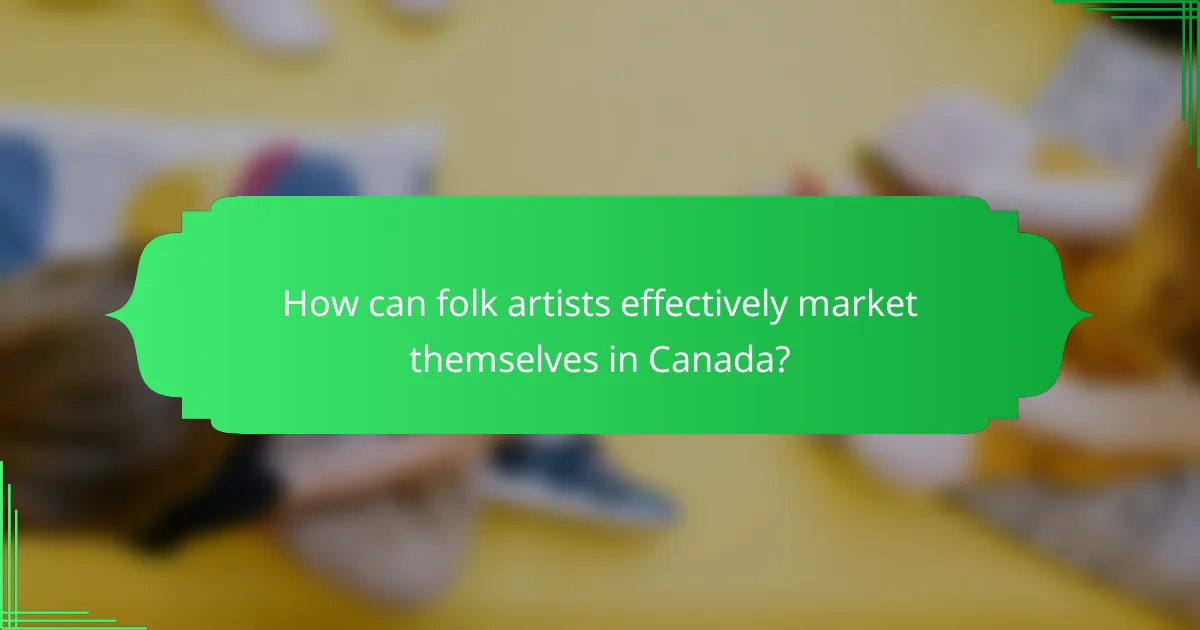
How can folk artists effectively market themselves in Canada?
Folk artists in Canada can effectively market themselves by leveraging digital platforms, engaging with their local communities, and collaborating with businesses. These strategies help build a strong presence and connect with audiences who appreciate their music.
Utilizing social media platforms
Social media platforms like Facebook, Instagram, and TikTok are essential for folk artists to reach a broader audience. Regularly posting updates, behind-the-scenes content, and live performances can engage fans and attract new listeners. Artists should consider using targeted ads to promote specific events or releases.
Engagement is key; responding to comments and messages fosters a sense of community. Utilizing hashtags relevant to folk music can also increase visibility among potential fans.
Engaging with local communities
Building relationships within local communities is crucial for folk artists. Participating in community events, open mics, and local gatherings allows artists to showcase their talent and connect with potential fans. This grassroots approach can lead to word-of-mouth promotion, which is invaluable.
Collaborating with local organizations or charities for events can enhance visibility and demonstrate commitment to the community, further solidifying an artist’s local presence.
Collaborating with local businesses
Partnering with local businesses can provide mutual benefits for folk artists and the businesses involved. For instance, performing at local cafes or shops can attract customers while giving artists a platform to showcase their music. In return, businesses can promote these events through their channels.
Artists should seek out sponsorship opportunities or co-host events with local brands, which can help expand their reach and create a loyal customer base.
Participating in music festivals
Music festivals are excellent opportunities for folk artists to gain exposure and connect with larger audiences. Many festivals in Canada feature local talent, providing a platform for artists to perform in front of enthusiastic crowds. Applying early and networking with festival organizers can increase chances of being selected.
Additionally, participating in these events allows artists to meet other musicians and industry professionals, potentially leading to future collaborations or gigs.
Creating a personal website
A personal website serves as a central hub for folk artists to showcase their music, biography, and upcoming events. It should include an easy-to-navigate layout, links to social media, and options for fans to subscribe to newsletters. This can help maintain engagement with followers and keep them informed about new releases or shows.
Including a blog section can also enhance SEO, drawing in more visitors. Artists should ensure their website is mobile-friendly, as many users will access it via smartphones.
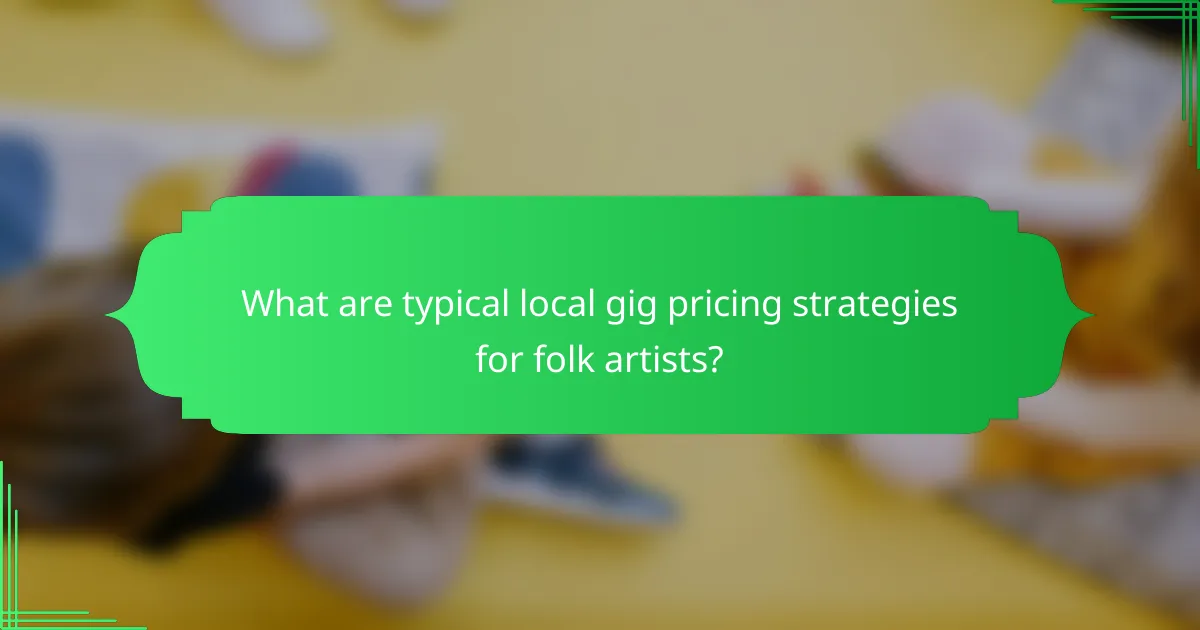
What are typical local gig pricing strategies for folk artists?
Folk artists typically use a variety of pricing strategies for local gigs, often based on their experience, venue type, and audience size. Prices can range significantly, influenced by factors such as local market conditions and the artist’s reputation.
Average pricing for local performances
Local gig pricing for folk artists generally falls between $100 and $500 per performance, depending on various factors. Emerging artists might charge lower rates, while established performers can command higher fees, especially in larger venues or festivals.
For example, a solo folk artist playing at a small café may charge around $150, while a band performing at a local festival could ask for $800 or more. Understanding local market rates is essential for setting competitive prices.
Factors influencing gig pricing
Other considerations include the duration of the performance, whether the artist is providing their own sound equipment, and any travel expenses incurred. Artists should assess these elements to determine a fair and competitive price.
Negotiation tips for better rates
Negotiating better rates for local gigs requires preparation and confidence. Artists should research typical pricing in their area and be ready to justify their rates based on experience and audience engagement. Presenting a strong portfolio can also enhance credibility.
When discussing fees, it’s beneficial to remain flexible and open to compromise. Offering to perform for a lower rate in exchange for merchandise sales or tips can also be a win-win for both the artist and the venue.
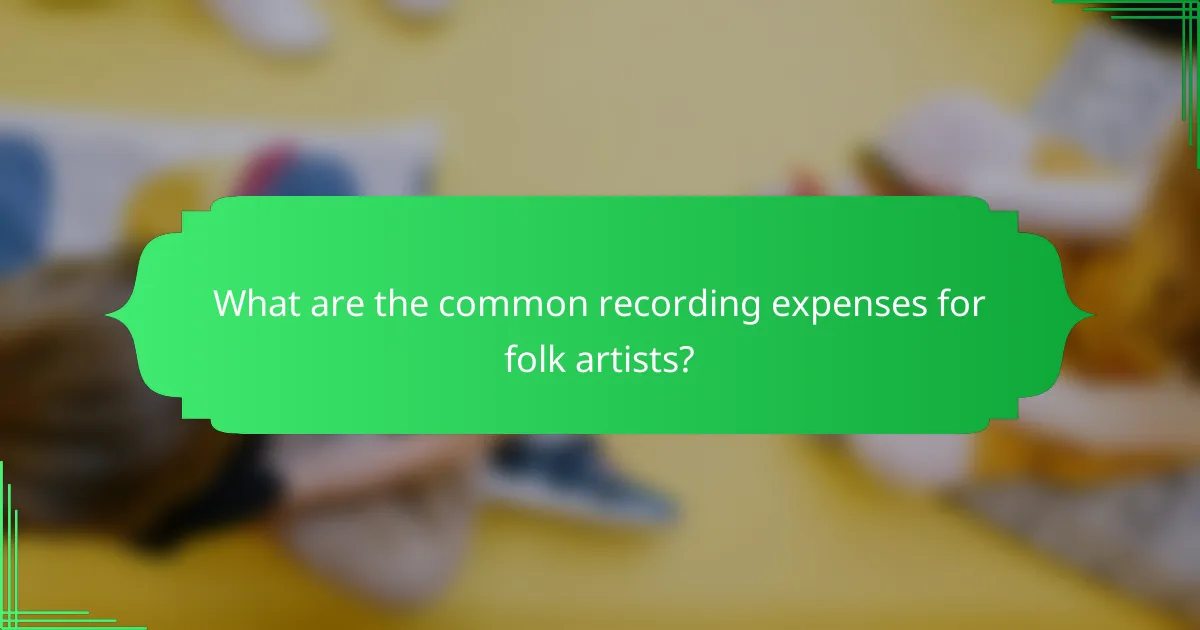
What are the common recording expenses for folk artists?
Folk artists typically face several recording expenses that can significantly impact their budgets. Key costs include studio rental, equipment and software, as well as mixing and mastering fees, all of which vary based on location and project scope.
Studio rental costs
Studio rental costs can vary widely depending on the location and the facilities offered. On average, rates may range from $25 to $150 per hour, with higher-end studios charging more for premium equipment and acoustics. It’s essential for folk artists to assess their budget and find a studio that meets their needs without overspending.
When selecting a studio, consider the length of time required for recording. Booking longer sessions can sometimes lead to discounted rates. Additionally, check if the studio offers package deals that include other services, which can help save money overall.
Equipment and software expenses
Investing in quality equipment and software is crucial for recording high-quality folk music. Costs for microphones, audio interfaces, and recording software can range from a few hundred to several thousand dollars, depending on the brand and specifications. Artists should prioritize essential gear that fits their style and sound.
Many folk artists start with basic equipment and gradually upgrade as their needs evolve. Renting equipment is another option to consider, especially for those who want to experiment with different sounds without a significant upfront investment.
Mixing and mastering fees
Mixing and mastering are critical steps in the recording process that can incur additional costs. Mixing fees typically range from $50 to $500 per track, while mastering can add another $50 to $200 per song. These services ensure that the final product sounds polished and professional.
To manage these expenses, folk artists can explore options such as collaborating with local producers or using online services that offer competitive rates. It’s advisable to listen to samples of previous work to ensure the quality meets expectations before committing to a service.
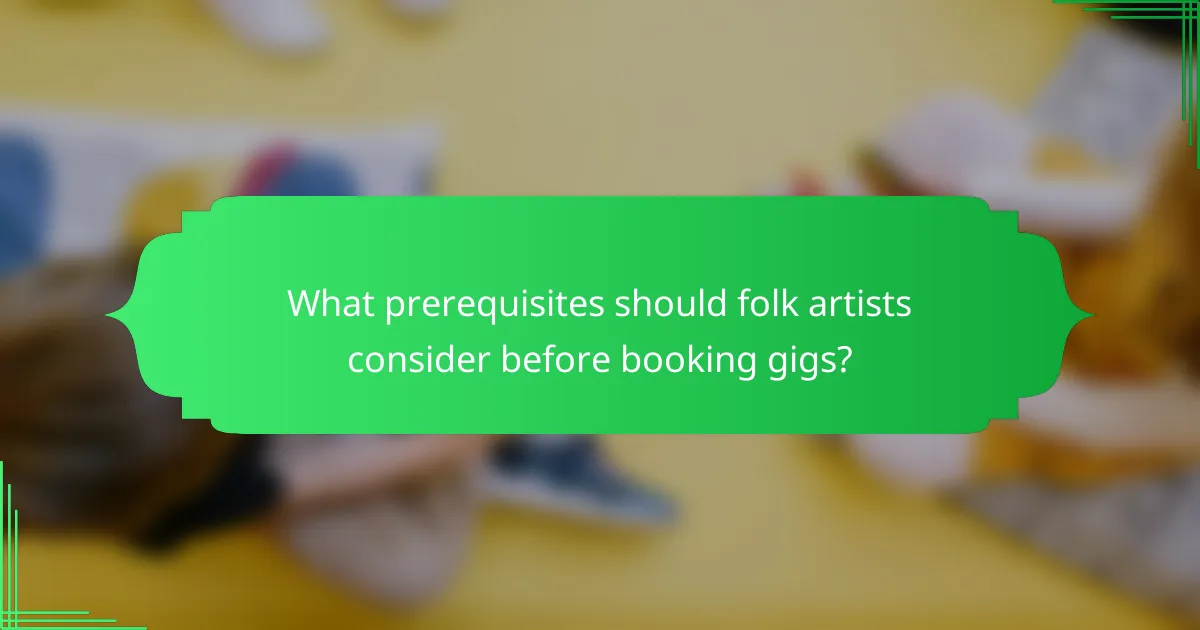
What prerequisites should folk artists consider before booking gigs?
Folk artists should evaluate their readiness by focusing on their portfolio and understanding local venue requirements. These factors significantly influence their ability to secure gigs and ensure successful performances.
Building a strong portfolio
A strong portfolio showcases an artist’s unique style and musical capabilities. It typically includes high-quality recordings, a selection of original songs, and live performance videos that highlight stage presence.
Artists should aim to have a diverse range of material that appeals to different audiences. Including testimonials or reviews from previous gigs can enhance credibility and attract potential venues.
Understanding local venue requirements
Each venue has specific requirements that artists must meet before booking. This can include sound equipment specifications, stage dimensions, and insurance coverage. Familiarizing oneself with these details can prevent last-minute complications.
Additionally, artists should be aware of local regulations regarding noise levels and performance permits. Researching these aspects can help in negotiating better terms and ensuring compliance with local laws.
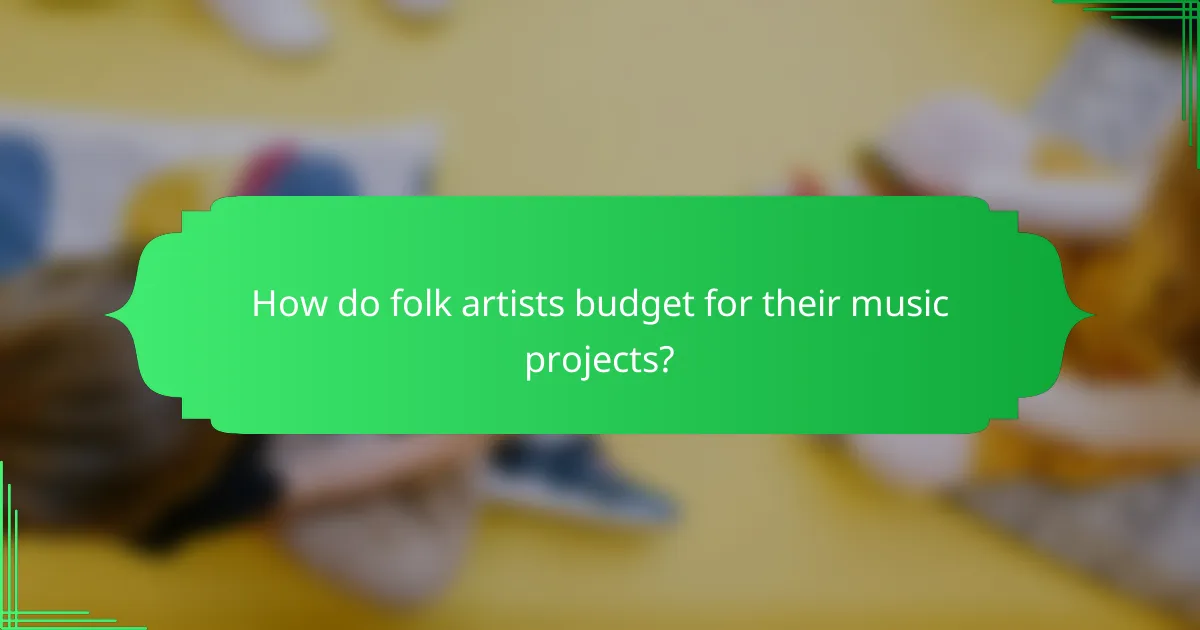
How do folk artists budget for their music projects?
Folk artists typically budget for their music projects by estimating costs for recording, marketing, and performances while identifying potential revenue sources. A well-structured budget helps them manage expenses and maximize their income from gigs and sales.
Creating a detailed budget plan
To create a detailed budget plan, folk artists should list all anticipated expenses, including studio time, equipment rental, marketing materials, and travel costs. For recording, expenses can range from a few hundred to several thousand dollars depending on the studio and production quality.
It’s also crucial to account for ongoing costs such as website maintenance and promotional activities. A good practice is to categorize expenses into fixed and variable costs to better understand cash flow needs.
Identifying potential funding sources
Folk artists can explore various funding sources to support their music projects, including grants, crowdfunding, and sponsorships. Local arts councils often provide grants that can cover recording or marketing expenses, while platforms like Kickstarter or Patreon allow artists to raise funds directly from fans.
Additionally, artists should consider partnerships with local businesses or venues that may offer sponsorships in exchange for promotional opportunities. Networking within the community can lead to valuable connections and financial support for upcoming projects.
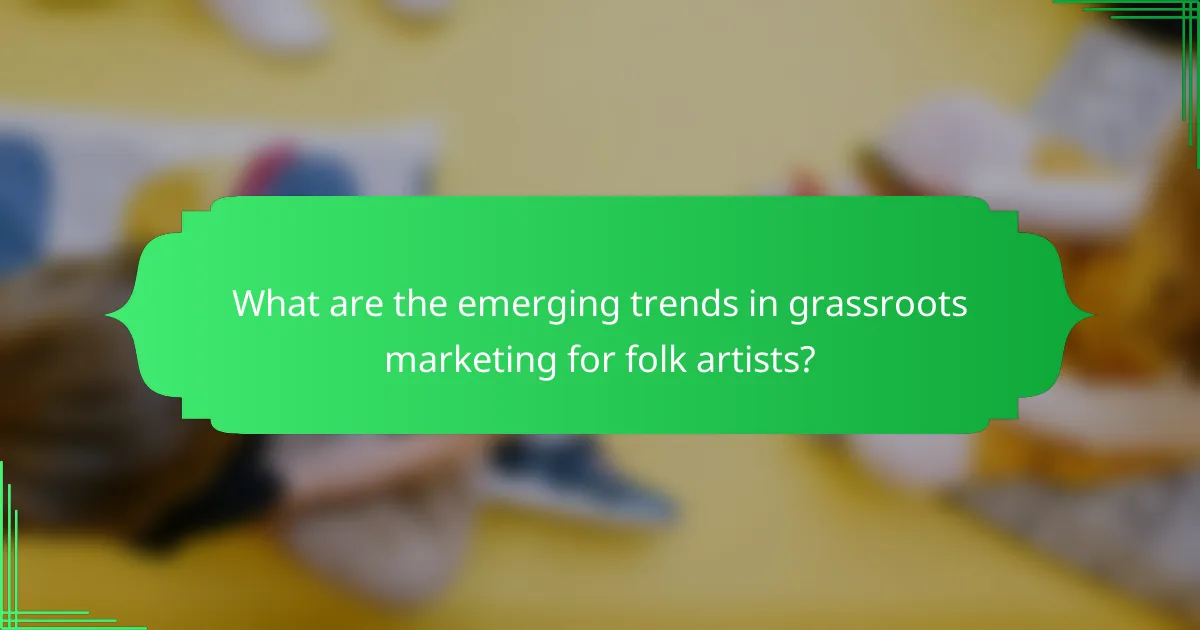
What are the emerging trends in grassroots marketing for folk artists?
Grassroots marketing for folk artists is increasingly focused on building direct connections with audiences through digital platforms and community engagement. Artists are leveraging innovative strategies to promote their music, fund projects, and enhance their visibility without relying solely on traditional industry channels.
Leveraging live streaming platforms
Live streaming platforms have become essential tools for folk artists to reach audiences directly and create interactive experiences. By hosting virtual concerts on platforms like Twitch or YouTube, artists can engage fans in real-time, often charging a small fee for access or accepting tips through digital wallets.
To maximize impact, artists should promote their live streams in advance on social media and through email newsletters. Offering exclusive content, such as behind-the-scenes footage or Q&A sessions, can also enhance viewer engagement and encourage more fans to participate.
Utilizing crowdfunding for projects
Crowdfunding has emerged as a viable option for folk artists to finance their music projects, from recording albums to organizing tours. Platforms like Kickstarter and Indiegogo allow artists to present their projects and set funding goals, often offering backers unique rewards such as signed merchandise or private performances.
When launching a crowdfunding campaign, artists should clearly communicate their project’s vision and budget. Setting realistic funding goals and promoting the campaign through social media and local networks can significantly increase the chances of success. Additionally, maintaining transparency with backers throughout the process fosters trust and encourages future support.

How can folk artists expand their reach beyond local markets?
Folk artists can expand their reach beyond local markets by leveraging digital platforms, collaborating with other artists, and engaging in grassroots marketing strategies. These approaches help build a broader audience and create opportunities for performances and sales outside their immediate area.
Grassroots marketing strategies for folk artists
Grassroots marketing involves engaging directly with the community and utilizing low-cost methods to promote music. Folk artists can host local events, participate in community festivals, and collaborate with local businesses to increase visibility. Social media platforms can also be powerful tools for sharing music and connecting with fans.
Building a mailing list is another effective grassroots strategy. Artists can collect email addresses at gigs or through their websites to keep fans informed about upcoming shows and releases. This direct communication fosters a loyal fan base and encourages word-of-mouth promotion.
Local gig pricing considerations
When setting prices for local gigs, folk artists should consider factors such as venue size, audience demographics, and local economic conditions. Pricing can vary widely, typically ranging from $5 to $20 for smaller venues, while larger events may command higher ticket prices. Understanding the local market can help artists set competitive rates.
Offering tiered pricing or special deals, like early bird tickets, can also attract more attendees. Additionally, artists should be mindful of the costs associated with performing, such as travel and equipment, to ensure that gig pricing covers expenses while remaining accessible to fans.
Recording expenses and budgeting
Recording expenses can be a significant investment for folk artists, with costs varying based on studio time, production quality, and distribution methods. Artists should budget for both recording and post-production, which can range from a few hundred to several thousand dollars depending on the project scope.
To manage costs, artists can explore home recording options or collaborate with local studios that offer affordable rates. Crowdfunding platforms can also be a viable way to raise funds for recording projects, allowing fans to support their favorite artists directly.
